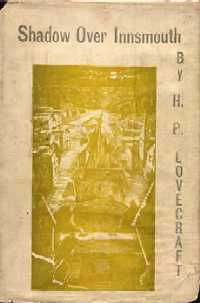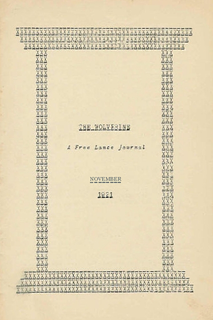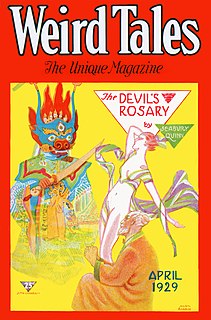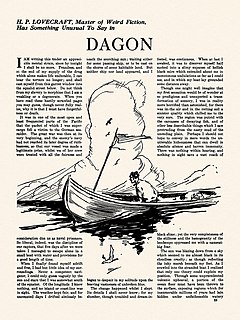Related Research Articles

Shub-Niggurath is a fictional deity created by writer H. P. Lovecraft. She is often associated with the phrase "The Black Goat of the Woods with a Thousand Young". The only other name by which Lovecraft referred to her was "Lord of the Wood" in his story The Whisperer in Darkness.

Azathoth is a deity in the Cthulhu Mythos and Dream Cycle stories of writer H. P. Lovecraft and other authors. He is the ruler of the Outer Gods, and may be seen as a symbol for primordial chaos.

The Shadow over Innsmouth is a horror novella by American author H. P. Lovecraft, written in November–December 1931. It forms part of the Cthulhu Mythos, using its motif of a malign undersea civilization, and references several shared elements of the Mythos, including place-names, mythical creatures, and invocations. The Shadow over Innsmouth is the only Lovecraft story that was published in book form during his lifetime.

"The Nameless City" is a short horror story written by American writer H. P. Lovecraft in January 1921 and first published in the November 1921 issue of the amateur press journal The Wolverine. It is often considered the first story set in the Cthulhu Mythos world. In the story, the protagonist travels to the middle of the Arabian Desert to explore an ancient underground city.

"The Dunwich Horror" is a horror novella by American writer H. P. Lovecraft. Written in 1928, it was first published in the April 1929 issue of Weird Tales (pp. 481–508). It takes place in Dunwich, a fictional town in Massachusetts. It is considered one of the core stories of the Cthulhu Mythos.

"The Haunter of the Dark" is a horror short story by American author H. P. Lovecraft, written between 5–9 November 1935 and published in the December 1936 edition of Weird Tales. It was the last written of the author's known works, and is part of the Cthulhu Mythos. The epigraph to the story is the second stanza of Lovecraft's 1917 poem "Nemesis".

"Pickman's Model" is a short story by H. P. Lovecraft, written in September 1926 and first published in the October 1927 issue of Weird Tales. It was adapted for television in a 1971 episode of the Night Gallery anthology series, starring Bradford Dillman.

"The Outsider" is a short story by American horror writer H. P. Lovecraft. Written between March and August 1921, it was first published in Weird Tales, April 1926. In this work, a mysterious individual who has been living alone in a castle for as long as he can remember decides to break free in search of human contact and light. "The Outsider" is one of Lovecraft's most commonly reprinted works and is also one of the most popular stories ever to be published in Weird Tales.

The Shadow Out of Time is a novella by American horror fiction writer H. P. Lovecraft. Written between November 1934 and February 1935, it was first published in the June 1936 issue of Astounding Stories. The story describes time and space travel by mind transfer. The premise is that a person in a given place and time can switch bodies with someone who is elsewhere or elsewhen. Other writers have re-used this concept in later works, such as drinking tea from Red Forest leaves in the television series 12 Monkeys and long-range communication stones in the Stargate SG-1 television series. As with other Lovecraftian works, this story features otherworldy alien beings that are not simply variations on humans or other familiar terrestrial animals.

"Dagon" is a short story by American author H. P. Lovecraft. It was written in July 1917 and is one of the first stories that Lovecraft wrote as an adult. It was first published in the November 1919 edition of The Vagrant. Dagon was later published in Weird Tales. It is considered by many to be one of Lovecraft's most forward-looking stories.
"The Unnamable" is a horror short story by American author H. P. Lovecraft. It was written in September 1923, first published in the July 1925 issue of Weird Tales, and first collected in Beyond the Wall of Sleep. The corrected text appears in Dagon and Other Macabre Tales,. The story's locale was inspired by the Charter Street Historic District Burying Ground in Salem.
"The Festival" is a short story by H. P. Lovecraft written in October 1923 and published in the January 1925 issue of Weird Tales.

The Whisperer in Darkness is a 26,000-word novella by American writer H. P. Lovecraft. Written February–September 1930, it was first published in Weird Tales, August 1931. Similar to The Colour Out of Space (1927), it is a blend of horror and science fiction. Although it makes numerous references to the Cthulhu Mythos, the story is not a central part of the mythos, but reflects a shift in Lovecraft's writing at this time towards science fiction. The story also introduces the Mi-Go, an extraterrestrial race of fungoid creatures.

"Cool Air" is a short story by the American horror fiction writer H. P. Lovecraft, written in March 1926 and published in the March 1928 issue of Tales of Magic and Mystery.

"The Lurking Fear" is a horror short story by American writer H. P. Lovecraft. Written in November 1922, it was first published in the January through April 1923 issues of Home Brew.
"The Evil Clergyman" is an excerpt from a letter written by American horror fiction writer H. P. Lovecraft in 1933. After his death, it was published in the April 1939 issue of Weird Tales as a short story. The story was later adapted into the unreleased 1987 anthology film Pulse Pounders.
The Mound is a horror/science fiction novella by American author H. P. Lovecraft, written by him as a ghostwriter from December 1929 to January 1930 after he was hired by Zealia Bishop to create a story about an Indigenous American mound which is haunted by a headless ghost. Lovecraft expanded the story into a tale about a mound that conceals a gateway to a subterranean civilization, the realm of K'n-yan. The story was not published during Lovecraft's lifetime. A heavily abridged version was published in the November 1940 issue of Weird Tales, and the full text was finally published in 1989.
"The Shambler from the Stars" is a horror short story by American writer Robert Bloch, first published in the September 1935 issue of Weird Tales. It was later included as part of his first published book, The Opener of the Way (1945), and his 1994 collection The Early Fears. A Cthulhu Mythos tale, it introduced the forbidden tome De Vermis Mysteriis. Later on in 1935, Lovecraft wrote the short story "The Haunter of the Dark" as a sequel and dedicated it to Bloch. Eventually, in 1950, Bloch wrote his own sequel "The Shadow from the Steeple".
Duane Weldon Rimel was an American writer of speculative and erotic literature who is best known for his friendship with H. P. Lovecraft.
References
- ↑ S. T. Joshi and David E. Schultz. An H. P. Lovecraft Encyclopedia. Westport, CT: Greenwood Press, 2001, p. 227